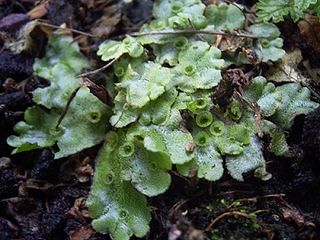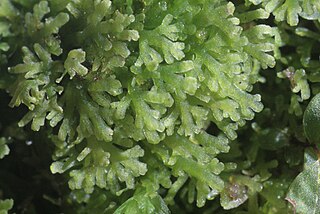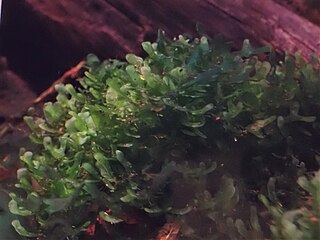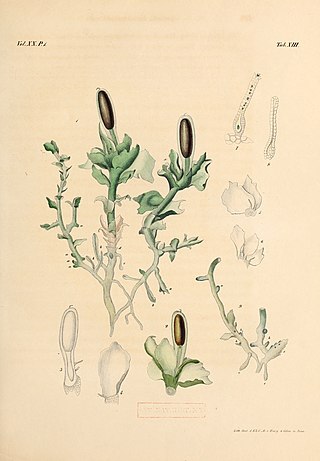
The Marchantiophyta are a division of non-vascular land plants commonly referred to as hepatics or liverworts. Like mosses and hornworts, they have a gametophyte-dominant life cycle, in which cells of the plant carry only a single set of genetic information.

Non-vascular plants are plants without a vascular system consisting of xylem and phloem. Instead, they may possess simpler tissues that have specialized functions for the internal transport of water.

An antheridium is a haploid structure or organ producing and containing male gametes. The plural form is antheridia, and a structure containing one or more antheridia is called an androecium. Androecium is also the collective term for the stamens of flowering plants.

Marchantiales is an order of thallose liverworts that includes species like Marchantia polymorpha, a widespread plant often found beside rivers, and Lunularia cruciata, a common and often troublesome weed in moist, temperate gardens and greenhouses.

Marchantiopsida is a class of liverworts within the phylum Marchantiophyta. The species in this class are known as complex thalloid liverworts. The species in this class are widely distributed and can be found worldwide.

Marchantia is a genus of liverworts in the family Marchantiaceae and the order Marchantiales.

Marchantia quadrata is a species of liverworts in the genus Marchantia. It was formerly classified in a separate genus Preissia, but was sunk into Marchantia in 2016. This genus has a worldwide distribution.

Metzgeriales is an order of liverworts. The group is sometimes called the simple thalloid liverworts: "thalloid" because the members lack structures resembling stems or leaves, and "simple" because their tissues are thin and relatively undifferentiated. All species in the order have a small gametophyte stage and a smaller, relatively short-lived, spore-bearing stage. Although these plants are almost entirely restricted to regions with high humidity or readily available moisture, the group as a whole is widely distributed, and occurs on every continent except Antarctica.

Monosolenium tenerum, is a weedy species of liverwort found in east Asia. It is the only species in the genus Monosolenium and the family Monosoleniaceae. It is commonly confused with similar-looking plants in the aquarium trade like Pellia liverworts and Süsswassertang, a fern gametophyte.

Loreleia is a genus of brightly colored agarics in the Hymenochaetales that have an omphalinoid morphology. They inhabit mosses and or liverworts on soil in temperate regions of the Northern Hemisphere. Phylogenetically related agarics are in the genera Contumyces, Gyroflexus, Rickenella, Cantharellopsis and Blasiphalia, as well as the stipitate-stereoid genera Muscinupta and Cotylidia and the clavaroid genus, Alloclavaria. However, the large number of DNA base-pair changes causes a long-branch to form in phylogenetic analyses depicted as cladograms.

Haplomitriopsida is a newly recognized class of liverworts comprising fifteen species in three genera. Recent cladistic analyses of nuclear, mitochondrial, and plastid gene sequences place this monophyletic group as the basal sister group to all other liverworts. The group thus provides a unique insight into the early evolution of liverworts in particular and of land plants in general.

Marchantia polymorpha is a species of large thalloid liverwort in the class Marchantiopsida. M. polymorpha is highly variable in appearance and contains several subspecies. This species is dioicous, having separate male and female plants. M. polymorpha has a wide distribution and is found worldwide. Common names include common liverwort or umbrella liverwort.

Aytoniaceae is a family of liverworts in the order Marchantiales.

Marchantia berteroana is a liverwort species in the genus Marchantia.

Hypolaetin is a flavone. It is the aglycone of hypolaetin 8-glucuronide, a compound found in the liverwort Marchantia berteroana. Hypolaetin 8-glucoside can be found in Sideritis leucantha.

Cephaloziaceae is a family of liverworts.
Caro Benigno Massalongo was an Italian botanist who specialized in the field of liverworts. He was the son of paleontologist Abramo Bartolommeo Massalongo (1824-1860).
Elizabeth Anne Brown was a New Zealand-born Australian bryologist who primarily contributed to the systematics of liverworts.

The oil bodies of liverworts, occasionally dubbed “complex” for distinction, are unique organelles exclusive to the Marchantiophyta. They are markedly different from the oil bodies found in algae and other plants in that they are membrane-bound, and are not associated with food storage. The organelles are variable and present in an estimated 90% of liverwort species, often proving taxonomically relevant. As a whole, the formation and function of the organelles are poorly understood. Complex oil bodies are recognized as sites of isoprenoid biosynthesis and essential oil accumulation, and have been implicated with anti-herbivory, desiccation tolerance, and photo-protection.

















